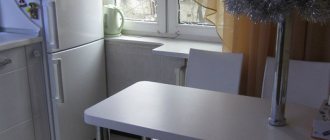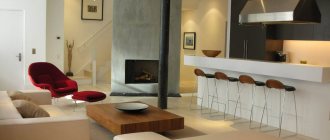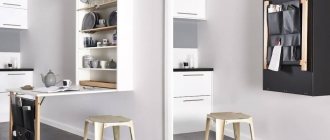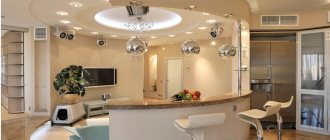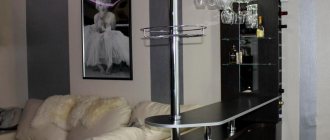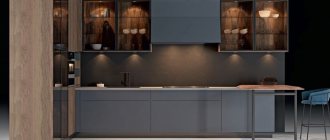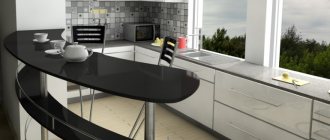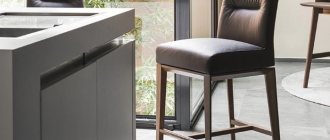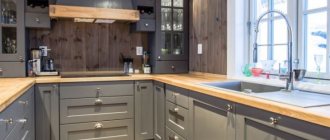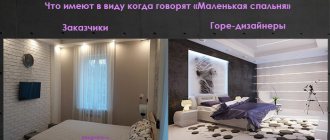| The best time to buy New Year's gifts is right now! Find the best gift ideas for Men, Women, Girls and Boys. |
When thinking about the design of a small kitchen, you can abandon the usual dining table and replace it with a modern alternative solution - a practical, stylish bar counter. Design solutions for this type of kitchen furniture allow you to choose an option for different interior styles. Read on to learn how to choose the right bar counter for a small kitchen made of high-quality material and conveniently place it in the room.
Features of kitchen design with a bar counter
Installing a bar counter in the kitchen is a fairly common solution for modern interiors.
To fully reveal the features of this find of modern design, it is necessary to talk about four things:
- Functions that a bar counter can perform. Simply put, why is it needed? It's not just for beauty. No, this is a useful, very practical component.
- How can you place this element of furniture? Where and how to fit it into a limited space? After all, the majority do not live in palaces. And at first glance it may seem that in the kitchen in a Khrushchev-era apartment there is simply no room for a whole bar counter... But this, of course, is not the case.
- What is this piece of furniture like from a constructive point of view? It's helpful to know what your options are right away. And evaluate what is needed to install them.
- Aesthetic possibilities of such a solution. A design is perceived as attractive and harmonious when all parts of the room, every detail, work together. They form a common style, a solid color scheme, and a single image. How to fit a bar counter into different styles? How to make it a decoration for your apartment?
When choosing a bar counter for your kitchen, you must take into account the height of your family members.
This article covers all four of these aspects in detail.
Kitchen studio layout
It’s easiest to talk about the functions performed by the bar counter using the example of a studio apartment. In such interiors, such a piece of furniture works especially clearly and clearly.
The layout should be such that it is easy for guests sitting at the bar to communicate with the hosts who are busy preparing food.
Bar counter and sofa
Function No. 1 - the bar counter is used to delimit space. It is necessary to somehow visually separate the food preparation area from the place for rest and leisure. For the same purposes, a sofa is often used, with its back facing the kitchen area and the seat facing the living part of the room.
It is better to choose the same material for the tabletop as for the main furniture.
Bar counter and table
Function No. 2 - this element can take on the role of a table. A dining room or work room, where the hostess prepares food. Sometimes this small oblong surface copes well with both tasks at once.
A bar extension of the countertop is a great option for small rooms. Often such models are made with various shelves, stands, and other useful decorative elements.
Advantages and disadvantages
A small kitchen with a breakfast bar has several advantages:
- The tabletop can be used as a dining area. As a result, space is saved and more free space remains. Used for quick snacks. This is convenient for residents of large cities, where every minute counts, and helps save time.
- A closed structure can become a storage space if you use part of it as a cabinet or shelves.
Closed option
- A small kitchen is often combined with a living room. The bar counter is used for zoning. In order for it to look visually harmonious, the design must repeat the design of the kitchen set.
Border between zones
- If the countertop is wide enough, you can put chairs under it so that they don’t take up extra space in an already small kitchen.
Minuses:
- The bar counter is complemented by non-standard high chairs with footrests, which are more convenient for people with good physical fitness and sufficient height to use. There is a risk of falling for children under 12 years of age and the elderly.
- In a small kitchen, 2-3 people can sit behind the bar at the same time. If the family is large, this may be inconvenient. The use is relevant for studio apartments, small-sized kitchens in Khrushchev-era buildings, and for small private houses.
The location of the bar counter in a small kitchen
In a separate kitchen, especially a small one, function No. 1 may not be fulfilled. There is no urgent need to distinguish between different zones. It is possible to separate the food preparation area from the dining area, but this is not necessary. And it's not even always possible.
When choosing the length, do not forget about the seating arrangement and the maximum number of people.
But function No. 2 is implemented just fine. In a kitchen with a modest area there is always a lack of work surfaces, and it is often unclear where to put the dining table. In this situation, a bar counter is a compact and convenient option to solve both problems at once:
- increase the working area;
- organize a place for eating.
Now is the time to touch on the question of how this can be done? What types of location of the bar counter are there in the space of a small kitchenette?
Perpendicular
The correctly selected size, configuration and location of the bar counter in a small kitchen will help create not only a beautiful, but also a functional interior, which is especially important for small spaces.
It can be installed perpendicular to the kitchen unit. As a continuation of the working surface, so that their joint contour in plan looks like the letter “G” or “P”. This is a very common and convenient solution.
Parallel
Due to its small width, the counter can replace a dining table, which is often difficult to place in a small kitchen.
It is less common to place a small kitchen unit with a bar counter in parallel. That is, a set of cabinets, shelves and household appliances along the wall. And a long horizontal tabletop - in the center of the room so that it follows the direction of the working area.
Note! Visually, this technique will further lengthen the room, making it more elongated, reminiscent of a train carriage. Therefore, it must be used with caution; it is not always appropriate.
Near the window
Sitting at such a bar counter is a pleasure, because you can admire the view from the window while drinking tea or enjoying a cup of coffee. However, if the view from your window leaves much to be desired, you should consider placing the bar counter in a different location.
You can make the bar counter a continuation of the window sill panel. Then you will have a dining corner where you can comfortably enjoy the view from the window. This idea allows you to use the window sill more rationally and save precious square meters.
At a free wall
If you decide to place the bar counter this way, you should think about the decorative design of the adjacent wall. Tiles or wallpaper with interesting patterns or designs will help offset this drawback.
In narrow, long rooms, sometimes the only possible place for a bar counter is the walls. As a continuation of the work surface of the corner kitchen unit. Or separately from it, as an independent object. The disadvantage of this way is that during a meal at a counter installed in this way, a person sits with his face almost close to a blank wall.
The advantage of this placement is that the bar counter can be made quite long depending on the length of the wall.
Note! You can make the surface above the bar counter more interesting with the help of well-chosen photos, decorative elements, and sconces. Such things not only make the space rich and cozy, but also visually expand it.
Folding bar counter
A transforming stand can serve as an alternative to a regular dining table, which makes it very relevant in small-sized kitchens.
A folding bar counter for a small kitchen is simply an ideal solution. It allows you to make the most of space. From a constructive point of view, such a piece of furniture is made in different ways:
- Folding option.
When the tabletop panel is folded, it leans against the wall. A special case of this solution is a transformable cabinet, the door of which, when open, acts as a table. - Retractable option.
When the stand, if desired, is completely retracted, for example, under the working surface of the headset.
Modern designers have come up with many ideas to optimize the functional use of kitchen units.
Sometimes there are less typical folding design solutions; you can try and invent something original yourself.
Device
A standard folding stand consists of three main elements: an upper and lower part, as well as a transforming mechanism. Let's look at each of the elements in more detail.
Upper part (table top)
A wide range of materials can be used to make countertops, such as:
- tree — when making countertops from natural wood, both budget materials (spruce, pine, larch) and more noble varieties (beech, oak, exotic species) are used. Natural solid wood can be given almost any shape, painted with carvings or decorative elements. The finished product has good performance characteristics, resistant to wear and mechanical damage;
- metal - a metal countertop will be appropriate in rooms designed in high-tech, loft or futurism style, as well as in combination with the main kitchen set made of a similar material. To make metal countertops, glossy or matte stainless steel, aluminum and even sheet copper are used. The finished tabletop is quite durable and resistant to mechanical damage. The disadvantages of a metal bar counter include unpleasant tactile sensations and poor combination with other interior solutions;
- laminated chipboard - is a modern, practical material. The base of the table top is made of chipboard. Decorative kraft paper is applied to the surface, acting as a decorative and fastening element. For protection, a layer of high-pressure plastic (overlay) is applied on top. As a result, the finished tabletop withstands mechanical damage well and is not afraid of moisture. The main advantages of a countertop made of LSDP are its decorative properties and price. The cost of material and work for this material is significantly lower than for products made from natural wood, stone or metal. And with the help of digital printing, a pattern can be applied to the surface of the chipboard that imitates wood, natural or artificial stone, or any ornament or pattern;
- MDF - differs from laminated chipboard only in the base material, which is fibreboard. Otherwise, the products have a similar production process - the base is covered with kraft paper, liquid plastic and laminated. The finished product is not resistant to impacts, scratches and excessive moisture. Using postforming, the surface can be designed to resemble natural materials or create your own unique pattern;
- a natural stone — countertops made of natural stone look very presentable, in addition, they are highly durable and durable. Due to the significant weight of the product, the use of natural stone in folding bar counters is quite problematic - for it you need to prepare a solid base;
- fake diamond - a modern composite material, texture and color imitating a natural stone panel. They are distinguished by their strength and durability, and if damaged they can be easily restored. They are considered an environmentally friendly material that does not emit harmful components. The only drawback can be considered the relatively high price, compared to other artificial materials;
- glass - a glass bar top can rightfully be considered the highlight of any interior. For its production, special high-strength glass is used, which can be: frosted;
- transparent;
- hardened;
- multi-colored with additional patterns.
A tabletop made of glass can be used in multi-level structures with other materials. It is distinguished by sufficient strength - it can only be broken with a targeted and very strong blow. This surface is not susceptible to moisture, high temperatures, or chemicals. If scratches or chips appear, it can be easily restored by polishing.
Each of the above materials has its own advantages and disadvantages, as well as requirements for care and operation.
Bottom part
The choice of material for the bottom of the bar directly depends on the countertop. First of all, it is necessary to calculate the load that will fall on the supporting structure.
For example, if the tabletop is made of metal, glass or stone, it is recommended to use metal supports. For laminated chipboard, MDF or natural wood, wooden legs are more suitable.
The design of the supports depends on the type of bar counter. Rotary models are equipped with a leg with a wheel at the bottom. Folding or folding bar counters use U-shaped or V-shaped folding supports equipped with a transforming mechanism. Using this system allows you to hide the leg under the tabletop when folded.
Transforming mechanism
Located between the top and bottom of the bar counter. Serves to move the tabletop to the “working” position. The type of mechanism used directly depends on the type of bar counter.
Roller mechanism. It is used in retractable models that are hidden under the main countertop of the kitchen unit. They are a combination of metal runners and plastic wheels.
Hinge mechanism. Used in rotary models. It consists of two metal or plastic plates with a special recess into which a bearing ball is installed.
Loop mechanism. Used in folding and folding models. The fastening scheme can be presented in two options:
- wall-tabletop;
- lower-upper parts of the bar counter.
Types of bar counters
To choose the design of a bar counter in the kitchen, you need to take into account the area of the kitchen, the presence of a separate dining table, the amount of cabinet furniture and, of course, the lifestyle of the owners.
When talking about folding examples of this piece of furniture, it’s hard not to think - what does it look like from a design point of view? And what types of bar counters are there based on their design? Although human imagination is limitless, most often there are 4 main options.
- Console.
When on one side the tabletop is attached to the wall (or to a window sill, cabinet, cabinet, or other piece of furniture), and the other simply hangs in the air. In order for such a design to be sufficiently reliable, the protruding part must be short in length, no more than a meter. - Panel supported by racks.
About the same as the legs of a table. There may be different numbers of them. From one massive monolithic support in the center, to 6-8 thin metal rods. The advantage of this design is its reliability. The downside is that sometimes it is impossible to remove bar stools under the counter due to the supports. That is, space is used inefficiently. - Hanging stand.
When a horizontal rack panel is suspended from the ceiling or sometimes from cabinets on the walls. In this case, cables and rigid metal rods can act as load-bearing elements. - Combined type: console plus stand.
On one side the tabletop is rigidly attached to the wall, and on the other it rests on a single stand. This seems to be the most common version of the design solution. It is especially often used for bar counters perpendicular to the kitchen unit. Its advantages: reliability, ease of execution, availability of free space under the tabletop.
Typically, racks are made of the same material from which the entire set is made: wood or plastic.
Note! With any design solution, some parameters remain unchanged. The height of this piece of furniture from the floor ranges from 0.9-1.3 meters. The width of the tabletop should be around 0.4-0.8 meters.
Table or stand
If you still haven't decided whether to get a bar table instead of a table, you can try combining these two interior elements. The bar counter combined with a dining table suggests a two-level option: the lower level acts as a dining table, and the upper one as a bar area. For families with children, this option will be the most successful: children will not have to sit on high chairs, and adults will be able to enjoy such an interior detail as a bar table.
Save space
In general, a bar counter for a small kitchen should not be bulky or too pretentious.
To save space, it is, of course, better to choose supports or hanging elements with a minimum cross-sectional size. So that there is as much free space as possible. Then the area under the counter can be used to store bar stools.
2) Along a free wall
The method is suitable for square or rectangular kitchens.
The structure is placed opposite the kitchen unit.
The length of the bar counter is not limited - this is a plus.
The downside is that you have to look at the wall.
Style
If you try, the bar counter in the kitchen will easily become the main and useful piece of furniture, as well as a place for cozy and cheerful gatherings with loved ones.
It is already quite clear that from a functional and constructive point of view, a bar counter in an ordinary small apartment is a great idea. It's time to talk about the aesthetic aspect of this decision.
Accessories
To expand functionality, rotating bar counters can be equipped with additional accessories, for example, a “carousel” mechanism or a “magic corner”.
It helps solve the problem of “dead corners” by unfolding when the rack is extended. In addition to it, the rack can be equipped with additional shelves for storing various kitchen items.
Interesting read:
Reader Julia: “The bar counter for glasses is the highlight of my kitchen interior”
“How I made a small and inconvenient kitchen into a large and functional one” - the story of our reader
Bar counter in a classic interior
Lighting the bar counter in the kitchen should be interesting when it is given a central place in the interior. Therefore, it is advisable to use several light sources that can be adjusted.
Modern classics are a solid formal style, rich in a significant amount of detail. A small kitchen with a bar counter in this style is not an easy task. It’s easy to make it too bulky, oversaturated with decorative elements, or cramped. What do you need to remember to avoid these common mistakes when designing it?
Preference for light colors
Material is also an important factor influencing the choice. Acrylic and plastic models can withstand weight up to 90 kg. Steel and wood are stronger.
White, cream, beige, light gray should be basic. They can be complemented with dark, gold, burgundy accents. But only in very measured doses.
Moderate amount of decor
To make the design original, you can assemble the model using slabs from different types of wood or decorating a model made of plasterboard with a beautiful mosaic.
There are very impressive kitchen sets with stucco on the doors, cornices, and pilasters. They fit amazingly into large rooms with high ceilings. But it is strictly not recommended to order them for little ones! On the contrary, you need to settle on something concise.
Natural materials
A wooden tabletop is good for its natural beauty, durability, versatility, warmth and the possibility of restoration. In addition, it is easier to care for as it repels dust.
Or materials that reliably imitate natural ones. Stone, wood, plaster. Of course, white paint, neutral wallpaper, discreet patterns, floral or geometric are also acceptable.
Natural stone is an expensive, durable and very beautiful material, but, unfortunately, it is not ideal. Marble is resistant to acids, grease and food dyes, and granite can be radioactive.
Note! The bar counter is exactly the place where you can relax your soul in modern classics. Supports stylized as columns, elegant brackets supporting the tabletop, vertical and horizontal edgings - all this is welcome.
MDF is a budget material that imitates wood or stone. It is quite impact-resistant and moisture-resistant.
Bar table in modern style
High-tech, eco-style, minimalism, loft - all these modern design trends love to use bar counters. What all these styles have in common is:
- minimum number of parts;
- contrasting colors;
- geometric simplicity of forms.
It’s good if the base of the bar counter is equipped with shelves, drawers, perhaps even a wine cabinet.
Everything else may vary. The design, materials, location are determined only by the imagination and taste of the author.
Tabletop materials
It is important to choose the right material for the bar counter; it affects the reliability of the structure, as well as the design of the product. When selecting, take into account the following points:
- sufficient strength;
- durability;
- resistance to aggressive factors (substances, humidity, temperature);
- visual appeal;
- environmental cleanliness.
Let's look at the most common types of materials.
- Chipboard. This is the cheapest and most unreliable solution. A wood board of this type quickly warps under the influence of moisture and temperature changes. Often the glue contains formaldehyde, which is unsafe for humans; to avoid problems, it is recommended to use chipboard with a protective laminated layer. In any case, a tabletop made of such material will not last long.
- Tree. Expensive material, but with excellent appearance. The disadvantage is that it is massive, which is not always appropriate in a small room.
- MDF. Wood board is an analogue of wood. Not inferior to wood in strength. A large number of finishing options allows you to achieve any appearance of the rack. Natural resin is used as glue, completely safe for humans.
- Plastic. Typically used in modern interiors. Nowadays bioplastics are often used. Disadvantages include poor resistance to impacts, as well as the risk of deformation when exposed to heat.
- Glass. Can be used in high-tech or other similar styles. Due to transparency, it significantly relieves space.
- Natural and artificial stone. Rarely used in small kitchens. Primarily due to its heavy weight, as well as its tendency to get dirty.
When choosing a tabletop for a bar counter, it makes sense to take into account recommendations for choosing colors. It is better to choose light-colored options, as dirt is less visible on them. Also, light colors make furniture visually smaller.
Tips for choosing a design
It remains to talk about a couple of techniques that have already proven themselves. Which the world's leading masters of interior design love to use.
- Accentuating the bar counter with light
For example, eye-catching pendant lamps. Or LED lighting along the contour of the tabletop. Then the room will be more interesting to perceive in the evening, its space will become more complex and, at the same time, more understandable. - Highlighting this piece of furniture with finishing
For example, you can line the wall and part of the ceiling above the tabletop with the same material, contrasting with its surroundings. This looks especially great when placing the counter against the wall, parallel to the line of the kitchen unit. - Application of a combined bar counter
Which is both a bar counter and something else. For example, a table more familiar to the older generation. That is, it has two horizontal panels at different levels, usually separated by a vertical wall. Or a bar counter that doubles as a cabinet. There are a variety of hybrids, sometimes they look very stylish.
To avoid hitting the corner of the tabletop every now and then, make it round.
A kitchenette can and should look chic. But for this you need to approach its design wisely.
Lighting
The bar counter can be decorated with the following types of lamps:
- suspended - mounted directly above the tabletop, on a special strip or directly on the ceiling. They create a soft light that accentuates the tabletop. Can be equipped with relays to control brightness;
- point - mounted on any selected surface (ceiling, wall or tabletop). Create a directional beam of light to highlight details or directed illumination of the work area;
- spots - are halogen lamps that are installed on a special rotating mechanism. Their use allows you to direct light to the desired point at any time;
- LED - LED strips are used both to create full lighting and for decorative purposes. They can change shape to adapt to the surface. Modern models are equipped with a remote control that allows you to change the brightness and color of the lighting.
